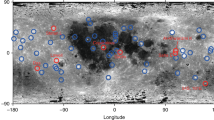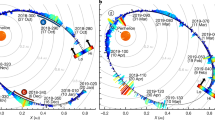Abstract
Very large collisions in the asteroid belt could lead temporarily to a substantial increase in the rate of impacts of meteorites on Earth. Orbital simulations predict that fragments from such events may arrive considerably faster than the typical transit times of meteorites falling today, because in some large impacts part of the debris is transferred directly into a resonant orbit with Jupiter1,2. Such an efficient meteorite delivery track, however, has not been verified. Here we report high-sensitivity measurements of noble gases produced by cosmic rays in chromite grains from a unique suite of fossil meteorites3 preserved in ∼480 million year old sediments. The transfer times deduced from the noble gases are as short as ∼105 years, and they increase with stratigraphic height in agreement with the estimated duration of sedimentation. These data provide powerful evidence that this unusual meteorite occurrence was the result of a long-lasting rain of meteorites following the destruction of an asteroid, and show that at least one strong resonance in the main asteroid belt can deliver material into the inner Solar System within the short timescales suggested by dynamical models.
This is a preview of subscription content, access via your institution
Access options
Subscribe to this journal
Receive 51 print issues and online access
$199.00 per year
only $3.90 per issue
Buy this article
- Purchase on Springer Link
- Instant access to full article PDF
Prices may be subject to local taxes which are calculated during checkout


Similar content being viewed by others
References
Gladman, B. J. et al. Dynamical lifetimes of objects injected into asteroid belt resonances. Science 277, 197–201 (1997)
Zappalà, V., Cellino, A., Gladman, B. J., Manley, S. & Migliorini, F. Asteroid showers on Earth after family breakup events. Icarus 134, 176–179 (1998)
Schmitz, B., Tassinari, M. & Peucker-Ehrenbrink, B. A rain of ordinary chondritic meteorites in the early Ordovician. Earth Planet. Sci. Lett. 194, 1–15 (2001)
Keil, K., Haack, H. & Scott, E. R. D. Catastrophic fragmentation of asteroids: Evidence from meteorites. Planet. Space Sci. 42, 1109–1122 (1994)
Bogard, D. D. Impact ages of meteorites: A synthesis. Meteoritics 30, 244–268 (1995)
Schmitz, B., Häggström, T. & Tassinari, M. Sediment-dispersed extraterrestrial chromite traces a major asteroid disruption event. Science 300, 961–964 (2003)
Patterson, D. B., Farley, K. A. & Schmitz, B. Preservation of extraterrestrial 3He in 480-Ma-old marine limestones. Earth Planet. Sci. Lett. 163, 315–325 (1998)
Baur, H. A noble-gas mass spectrometer compressor source with two orders of magnitude improvement in sensitivity. Eos 46, F1118 (1999)
Schmitz, B., Lindström, M., Asaro, F. & Tassinari, M. Geochemistry of meteorite-rich marine limestone strata and fossil meteorites from the lower Ordovician at Kinnekulle, Sweden. Earth Planet. Sci. Lett. 145, 31–48 (1996)
Marti, K. & Graf, T. Cosmic-ray exposure history of ordinary chondrites. Annu. Rev. Earth Planet. Sci. 20, 221–243 (1992)
Wieler, R. Cosmic-ray produced noble gases in meteorites. Rev. Mineral. Geochem. 47, 125–170 (2002)
Farinella, P., Vokrouhlický, D. & Morbidelli, A. in Accretion of Extraterrestrial Matter Throughout Earth's History (eds Peucker-Ehrenbrink, B. & Schmitz, B.) 31–49 (Kluwer, New York, 2001)
Bottke, W. F., Vokrouhlický, D., Rubincam, D. P. & Brož, M. in Asteroids III (eds Bottke, W. F., Cellino, A., Paolicchi, P. & Binzel, R. P.) 395–408 (Univ. Arizona Press, Tucson, 2002)
Morbidelli, A. & Gladman, B. Orbital and temporal distributions of meteorites originating in the asteroid belt. Meteorit. Planet. Sci. 33, 999–1016 (1998)
Bottke, W. F. et al. Debiased orbital and absolute magnitude distribution of the near-Earth objects. Icarus 156, 399–433 (2002)
Gaffey, M. J. et al. Mineralogical variations within the S-type asteroid class. Icarus 106, 573–602 (1993)
Binzel, R. P., Lupishko, D. F., Di Martino, M., Whiteley, R. J. & Hahn, G. J. in Asteroids III (eds Bottke, W. F., Cellino, A., Paolicchi, P. & Binzel, R. P.) 255–271 (Univ. Arizona Press, Tucson, 2002)
Gradie, J. & Tedesco, E. F. Compositional structure of the asteroid belt. Science 216, 1405–1407 (1983)
Nesvorný, D., Morbidelli, A., Vokrouhlický, D., Bottke, W. F. & Brož, M. The Flora family: A case of the dynamically dispersed collisional swarm? Icarus 157, 155–172 (2002)
Leya, I., Lange, H.-J., Neumann, S., Wieler, R. & Michel, R. The production of cosmogenic nuclides in stony meteoroids by galactic cosmic-ray particles. Meteorit. Planet. Sci. 35, 259–286 (2000)
Leya, I. & Wieler, R. Nucleogenic production of Ne isotopes in Earth's crust and upper mantle induced by alpha particles from the decay of U and Th. J. Geophys. Res. 104, 15439–15450 (1999)
Jianhua, Z. Middle Ordovician conodonts from the Atlantic faunal region and the evolution of key conodont genera. Meddn Stockh. Univ. Inst. Geol. Geokem. 298, 1–27 (1998)
Acknowledgements
We thank M. Tassinari for help with recovery of chromite grains, I. Leya for discussions, G. Quitté and U. Wiechert for help in the laboratory and W. F. Bottke for comments on the manuscript. Field work was funded by the National Geographic Society.
Author information
Authors and Affiliations
Corresponding author
Ethics declarations
Competing interests
The authors declare that they have no competing financial interests.
Supplementary information
Supplementary Figures
Figure 1 shows the preservation state of chromite grains based on corrosion and ZnO content. Figure 2 shows a neon three-isotope diagram, allowing to deduce the composition of trapped Ne in each grain. (DOC 401 kb)
Supplementary Table 1
This table gives the complete helium and neon data as measured in the chromite grains, as well as calculated cosmogenic and nucleogenic neon concentrations and nominal exposure ages. (XLS 35 kb)
Supplementary Discussion
In this file the corrections for non-cosmogenic 3He and 21Ne are explained in more detail. In addition, we discuss possible reasons for the somewhat low nominal exposure age of sample Glaskarten 001. (DOC 25 kb)
Rights and permissions
About this article
Cite this article
Heck, P., Schmitz, B., Baur, H. et al. Fast delivery of meteorites to Earth after a major asteroid collision. Nature 430, 323–325 (2004). https://doi.org/10.1038/nature02736
Received:
Accepted:
Issue Date:
DOI: https://doi.org/10.1038/nature02736
This article is cited by
-
Asteroid families: properties, recent advances, and future opportunities
Celestial Mechanics and Dynamical Astronomy (2022)
-
Middle Ordovician astrochronology decouples asteroid breakup from glacially-induced biotic radiations
Nature Communications (2021)
-
Asteroid shower on the Earth-Moon system immediately before the Cryogenian period revealed by KAGUYA
Nature Communications (2020)
-
Rare meteorites common in the Ordovician period
Nature Astronomy (2017)
-
Meteorites: A shift in shooting stars
Nature Astronomy (2017)
Comments
By submitting a comment you agree to abide by our Terms and Community Guidelines. If you find something abusive or that does not comply with our terms or guidelines please flag it as inappropriate.



